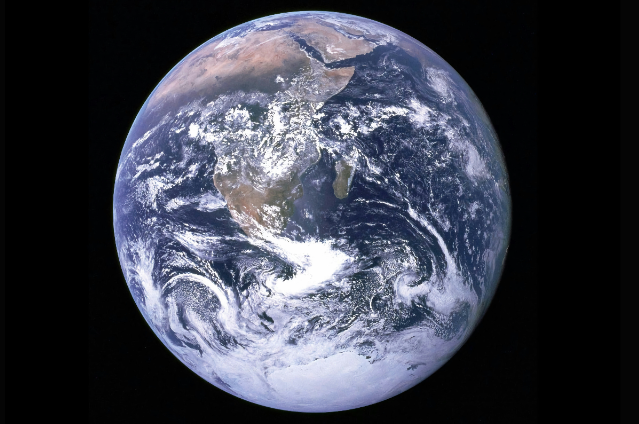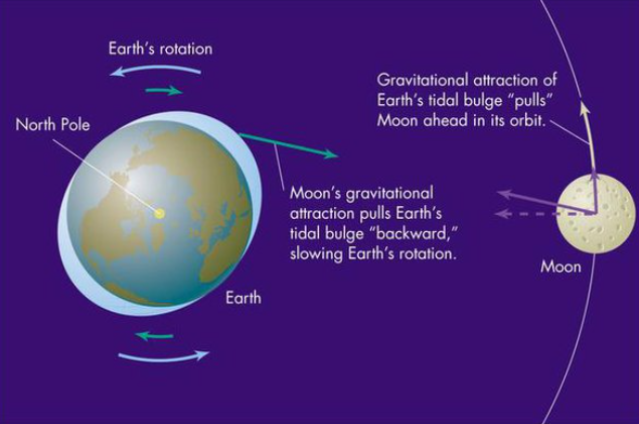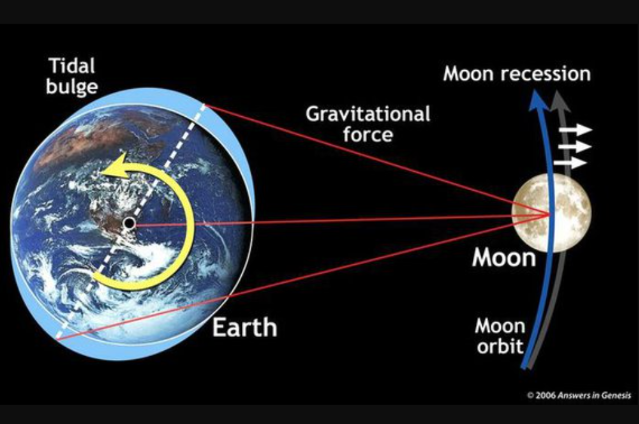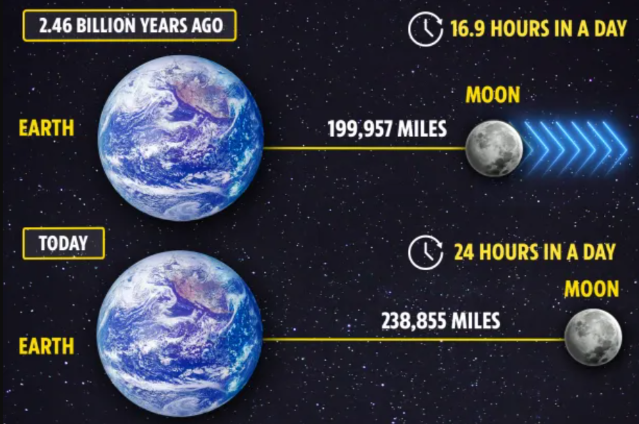
Photo by NASA on Unsplash
Imagine a future where the clock ticks differently, and a full day on Earth stretches to 25 hours. This isn't the plot of a science fiction novel but a potential reality, driven by a silent and steady dance between Earth and its only natural satellite, the Moon.
The future paints a fascinating picture where the concept of a day extends beyond the familiar 24 hours, lingering just a bit longer. Imagine a world where time feels different, where the sun hangs in the sky for an extra hour, allowing for more moments of daylight, exploration, and connection. This scenario is not merely a figment of imagination; it is grounded in real scientific research.
Recent studies indicate that the Moon is gradually drifting away from Earth at a rate of approximately 3.8 centimeters per year. This slow yet steady movement has profound implications for our planet's rotation. According to researchers from the University of Wisconsin-Madison, in about 200 million years, the length of a day on Earth could extend to 25 hours. This gradual increase in day length is a result of the tidal forces exerted by the Moon, which slow down Earth's rotation over time.
The relationship between the Earth and the Moon is dynamic and complex. Over 1.4 billion years ago, when the Moon was significantly closer to Earth, a day lasted just over 18 hours. As the Moon has drifted away, Earth's rotation has gradually slowed, leading to the 24-hour day we experience today. This ongoing drift suggests that our planet's timekeeping will continue to evolve, offering insights into the intricate forces that shape our environment and the celestial mechanics at play in our solar system
The Celestial Dance: Moon’s Gradual Drift
| Orbit distance from Earth | Average 384,400 km (238,900 mi) |
| Rotation and Revolution | Tidally locked, presenting the same face to Earth. Lunar day equals lunar month, approximately 29.5 Earth days. |
| Significance in Earth's Tides | Moon's gravitational pull is a primary factor in Earth's tides. |
| Size | Diameter about 3,474 km |
| Surface Features | Surface covered in lunar dust, features mountains, craters, and maria (basaltic plains). |
| First Human Landing | July 20, 1969, by Apollo 11's Eagle module. |
| Surface Gravity | About 1.622 m/s², one sixth of Earth's. |
The relationship between the Earth and the Moon has always been a fascinating interplay of celestial forces. For billions of years, the Moon has exerted its gravitational pull on our planet, shaping the tides and influencing the speed of Earth's rotation. In fact, 1.4 billion years ago, when the Moon was much closer to Earth, a day lasted just over 18 hours.
The Ebb and Flow of Time
Throughout Earth's history, the Moon has been a constant presence, its gravitational pull shaping the tides and influencing the speed of our planet's rotation. About 1.4 billion years ago, when the Moon was much closer to Earth, a day lasted just over 18 hours. As the Moon has slowly drifted away over time, the length of a day has gradually increased, a testament to the intricate dance of gravitational forces that govern our celestial mechanics.
Astrochronology: Unraveling the Past
At the University of Wisconsin-Madison, researchers like geoscientist Stephen Meyers have employed the technique of astrochronology to uncover the secrets of the Earth-Moon relationship. By analyzing ancient geological formations and sediment layers, they have been able to track the history of this celestial embrace, revealing how the Moon's recession has influenced Earth's rotational speed over billions of years.
The Implications of a 25-Hour Day
As the Moon continues to drift away, the prospect of a 25-hour day becomes increasingly real. In about 200 million years, if the current rate of recession persists, our planet could experience a significant shift in the way we perceive and organize time. Imagine children playing in parks bathed in the gentle light of dusk, families gathering for extended dinners, and cities thrumming with activity long into the evening hours. This extra time could have profound implications for human life, ecosystems, and even the economy, as we adapt to the altered rhythms of our world.
The Delicate Balance of Life
The gradual drift of the Moon serves as a reminder of the delicate balance that sustains life on our planet. As the Moon moves further away, its gravitational influence on Earth's climate, tides, and overall stability will continue to evolve. This phenomenon underscores the interconnectedness of the solar system, where even the smallest changes can lead to significant consequences. By understanding the cosmic forces at play, we gain a deeper appreciation for the unique conditions that have allowed life to flourish on Earth and our responsibility to protect this delicate balance.
Current Phenomenon:
The Moon is currently receding from Earth at a rate of approximately 3.8 centimeters per year, a figure that might seem trivial in the short term but accumulates significantly over geological time. This gradual drift is primarily due to the gravitational interactions between the Earth and the Moon, which create tidal forces that influence both bodies.
Historically, this relationship has been pivotal in shaping the Earth's rotational speed and the nature of its tides. About 1.4 billion years ago, when the Moon was much closer to Earth, a day on our planet lasted just over 18 hours. As the Moon has slowly drifted away, the length of a day has gradually increased due to the conservation of angular momentum within the Earth-Moon system.
The current rate of the Moon's recession, while seemingly minor—akin to the rate at which fingernails grow—has profound implications for the future. Over millions of years, this slow drift could result in Earth days extending to 25 hours, fundamentally altering life on our planet. The ongoing separation highlights the dynamic nature of the Earth-Moon relationship and serves as a reminder of the intricate forces that govern our celestial surroundings.
The Science Behind the Moon's Gradual Recession
Gravitational Interactions
The gradual recession of the Moon from Earth is primarily caused by tidal forces resulting from the gravitational interactions between the two celestial bodies. As the Earth rotates, the Moon's gravity creates bulges in the Earth's oceans, leading to tides. These tidal bulges are slightly ahead of the Moon due to the Earth's rotation, creating a net forward force on the Moon. This forward force transfers angular momentum from the Earth's rotation to the Moon's orbit, causing the Moon to slowly move further away.
Measuring the Recession Rate
Lunar laser ranging, a technique that involves bouncing lasers off reflectors placed on the lunar surface by Apollo astronauts, has allowed scientists to precisely measure the Moon's recession rate. According to these measurements, the Moon is currently moving away from Earth at a rate of approximately 3.82 ± 0.07 centimeters per year.
The Figure Skater Analogy
Imagine a figure skater spinning on ice. When their arms are extended, their rotational speed is slower. However, as they draw their arms in closer to their body, their rotational speed increases due to the conservation of angular momentum. Similarly, as the Moon moves further away from Earth, the Earth's rotational speed slows down to conserve the overall angular momentum of the system.
The Roche Limit and Its Significance
The Roche limit is the distance from a celestial body within which a second celestial body, held together only by its own force of gravity, will disintegrate because the first body's tidal forces exceed the second body's self-gravitation. For the Earth-Moon system, the Roche limit is approximately 18,400 kilometers (11,500 miles). The Moon currently orbits well outside this limit, ensuring its stability
Historical Evidence
Ancient geological records, such as tidally laminated sediments and coral reef bands, provide evidence that the Moon's recession rate has not been constant over time. These records show that the tidal forces exerted by the Moon on Earth have varied significantly due to changes in the configuration of continents and ocean basins.
Implications for Earth's Rotation
As the Moon recedes, it also affects the length of a day on Earth. The transfer of angular momentum from the Earth's rotation to the Moon's orbit causes the Earth's spin to slow down. Approximately 1.4 billion years ago, a day on Earth lasted just over 18 hours, compared to the current 24-hour day.
Resolving the Apparent Contradiction
Some creationists have argued that the Moon's recession rate poses a problem for the old-Earth view, as simple calculations suggest that the Moon would have been too close to Earth in the past. However, this argument assumes a constant recession rate, which is not supported by the geological evidence.
Research by physicist Kirk Hansen has shown that the Moon's tidal torque on Earth has varied significantly over time due to changes in the configuration of continents and ocean basins. During periods when Earth had a single supercontinent, the tidal torque was much lower, allowing the Moon to be a comfortable distance from Earth even 4.5 billion years ago.
The gradual recession of the Moon is a well-established phenomenon that provides valuable insights into the Earth-Moon system's history and evolution. By combining modern laser measurements with ancient geological records, scientists have gained a deeper understanding of the complex interplay between tidal forces, continental drift, and Earth's rotation. Far from posing a problem for the old-Earth view, the Moon's recession is consistent with the overwhelming scientific evidence for Earth's great age.
The Research Behind the Numbers
University of Wisconsin-Madison Study
At the University of Wisconsin-Madison, researchers led by geoscientist Stephen Meyers have conducted extensive studies exploring the complex relationship between the Earth and the Moon. Their work employs the technique of astrochronology, which links astronomical events with geological records to provide insights into the history of the Earth-Moon system and its implications for Earth's rotational speed over billions of years.
Methodology: Astrochronology and Geological Analysis
Astrochronology is a sophisticated method that allows scientists to establish precise geological time scales by correlating sedimentary rock layers with periodic astronomical cycles, such as changes in Earth's orbit and axial tilt. In their research, Meyers and his team focused on ancient geological formations and sediment layers, some dating back hundreds of millions to billions of years.
Examination of Geological Formations
The researchers examined sedimentary records from rock formations that are approximately 90 million years old. By analyzing these layers, they were able to track the historical changes in the Earth-Moon system. The sediment layers contain information about past environmental conditions, which can be correlated with known astronomical cycles. This correlation helps create a timeline of Earth's geological history, revealing how the Moon's recession has influenced Earth's rotational dynamics.
Insights into Earth's Rotational Speed
The findings from this research indicate that the Moon's current rate of recession—approximately 3.8 centimeters per year—has been relatively stable over geological time. However, this rate has experienced fluctuations due to various factors, including changes in Earth's rotational speed and continental drift. The study highlights that about 1.4 billion years ago, a day on Earth lasted just over 18 hours, demonstrating how the Earth-Moon relationship has evolved.
Meyers emphasizes the ambition of using astrochronology to "tell time in the most distant past," aiming to develop ancient geological time scales that can be compared to modern geological processes. By integrating astrochronology with traditional geological methods, researchers can gain a deeper understanding of the forces that have shaped our planet and its relationship with the Moon.
The research conducted at the University of Wisconsin-Madison exemplifies the innovative approaches scientists are taking to unravel the complexities of the Earth-Moon system. By employing astrochronology to analyze ancient geological records, researchers like Stephen Meyers are providing valuable insights into how Earth's rotational speed has changed over billions of years. This work not only enhances our understanding of the Earth-Moon relationship but also sheds light on the dynamic processes that govern our planet's evolution.
Implications for the Future
The 25-Hour Day
Imagine a world where the sun lingers in the sky for an extra hour each day, casting a warm glow that lingers just a bit longer. In this future, where a day extends to 25 hours, the rhythms of life would shift subtly yet profoundly. Children would play in parks bathed in the gentle light of dusk, families would gather for extended dinners, and the bustling energy of cities would stretch into the evening hours.
This extra time could have significant implications for human life, allowing for more leisure activities, educational pursuits, and personal growth. Businesses might adapt to the longer days, offering extended hours or even shifting to a 25-hour workday. Ecosystems would also be affected, with plants and animals adjusting to the altered light cycles. Farmers might need to adapt their planting and harvesting schedules to accommodate the changing day length.
Long-Term Perspective
While the prospect of a 25-hour day is fascinating, it is important to consider the long-term implications of the Moon's gradual recession. As the Moon drifts further away, it could have a significant impact on Earth's climate, tides, and overall stability. Changes in the Moon's gravitational pull could affect ocean currents, weather patterns, and even the stability of Earth's axial tilt, which is crucial for maintaining seasonal changes.
However, it is important to note that even though the Moon is moving away from Earth at a rate of approximately 3.8 centimeters per year, it will not disappear from our sky anytime soon. The Moon is currently about 384,400 kilometers (238,855 miles) away from Earth, and it would take billions of years for it to drift so far away that it would no longer be visible from our planet.
The gradual recession of the Moon is a testament to the dynamic nature of the Earth-Moon relationship. While the prospect of a 25-hour day is intriguing, it is essential to consider the long-term implications of this phenomenon. As we look to the future, we must strive to understand and adapt to the changes that will come with the Moon's continued drift, ensuring that we maintain the delicate balance of life on our planet.
The Bigger Picture: Earth and Its Place in the Cosmos
Broader Implications
The gradual recession of the Moon from Earth provides profound insights into our planet's place in the universe. This phenomenon underscores the importance of celestial mechanics in shaping the future of Earth. The gravitational interplay between the Earth and the Moon is a prime example of how cosmic forces influence planetary behavior, including rotation, climate, and tidal patterns.
As the Moon drifts away, it affects Earth's rotational speed and the stability of its axial tilt, which is crucial for maintaining seasonal variations. Such changes can have cascading effects on climate systems, ocean currents, and even the biosphere. Understanding these dynamics not only enhances our knowledge of Earth's past but also equips us to better predict its future in an ever-evolving cosmic landscape.
Moreover, the Earth-Moon relationship exemplifies the delicate balance of forces that govern celestial bodies. The Moon's influence on Earth is a reminder of the interconnectedness of the solar system, where even the smallest changes can lead to significant consequences. This perspective encourages us to appreciate the intricate web of interactions that sustain life on our planet and to recognize our responsibility in preserving this delicate balance.
Comparative Analysis
When comparing Earth's experience with that of other planets and moons in the solar system, the uniqueness of the Earth-Moon relationship becomes evident. For instance, while Mars has two small moons, Phobos and Deimos, they do not exert the same gravitational influence on the planet as the Moon does on Earth. The lack of a substantial moon means Mars experiences less pronounced tidal effects and a more erratic rotational stability.
In contrast, gas giants like Jupiter have numerous moons, but their immense size and distance from the Sun create different gravitational dynamics. For example, Jupiter's largest moon, Ganymede, is significantly larger than Mercury, yet it does not influence Jupiter's rotation in the same way the Moon influences Earth.
This comparison highlights the delicate balance of the Earth-Moon system, which has evolved over billions of years to create conditions uniquely suited for life. The Moon's gravitational pull stabilizes Earth's axial tilt, contributing to a relatively stable climate that has allowed life to flourish. In this context, Earth stands out as a rare gem in the solar system, with a moon that plays a critical role in maintaining the conditions necessary for life.
The gradual drift of the Moon serves as a reminder of the dynamic and interconnected nature of our universe. As we explore the broader implications of this phenomenon, we gain a deeper understanding of Earth's place in the cosmos and the celestial mechanics that shape its future. While the Moon is drifting away, it will not disappear from our sky anytime soon, remaining a vital companion in our journey through the universe. This enduring relationship invites us to reflect on our responsibility to protect and sustain the delicate balance that allows life to thrive on our planet.
Conclusion
In summary, the gradual drift of the Moon away from Earth at a rate of approximately 3.8 centimeters per year is a slow yet impactful process with significant implications for our planet. Over the course of millions of years, this drift could extend the length of a day on Earth to 25 hours, fundamentally altering our experience of time and life itself. The research conducted by scientists at the University of Wisconsin-Madison, particularly through the lens of astrochronology, has provided valuable insights into the historical dynamics of the Earth-Moon relationship and how it has shaped our planet's rotational speed over billions of years.
This discovery is awe-inspiring, as it deepens our understanding of the interconnectedness of celestial bodies. The Earth-Moon relationship exemplifies the delicate balance of forces that govern our planet and highlights the intricate dance of gravitational interactions that sustain life. As we contemplate the future, we are reminded of the cosmic forces at play and how they influence the very fabric of our existence.
Let us take a moment to appreciate the delicate balance of our planet and the celestial mechanics that shape our world. As we learn about the gradual changes occurring in our cosmic neighborhood, we should recognize that even the smallest shifts can have profound effects on life as we know it. By fostering a sense of wonder and responsibility towards our planet and its place in the universe, we can work together to protect the intricate systems that support life and ensure a sustainable future for generations to come.
. . .
References:



